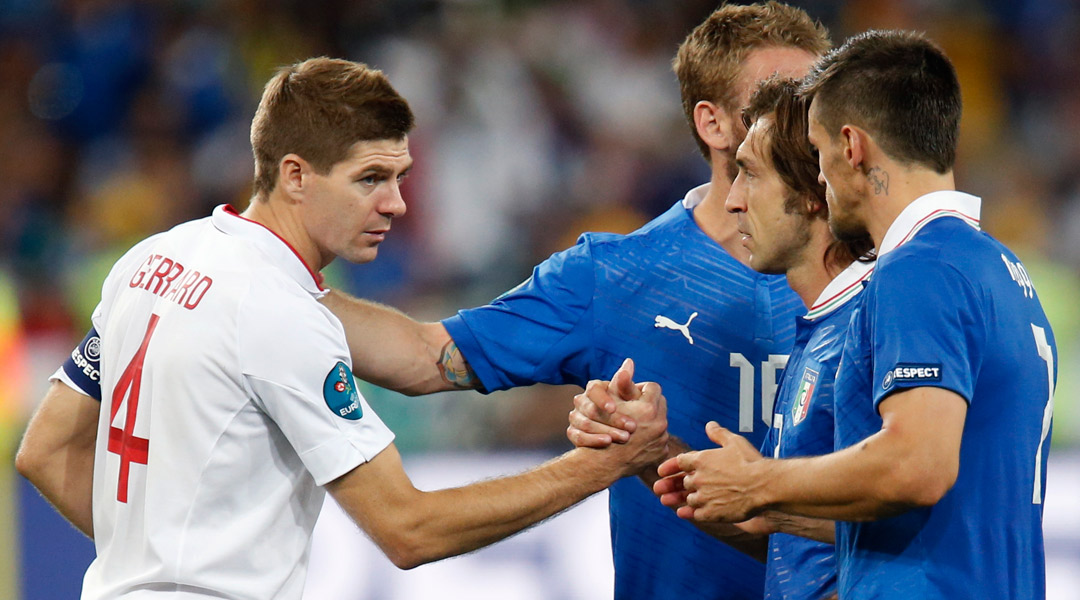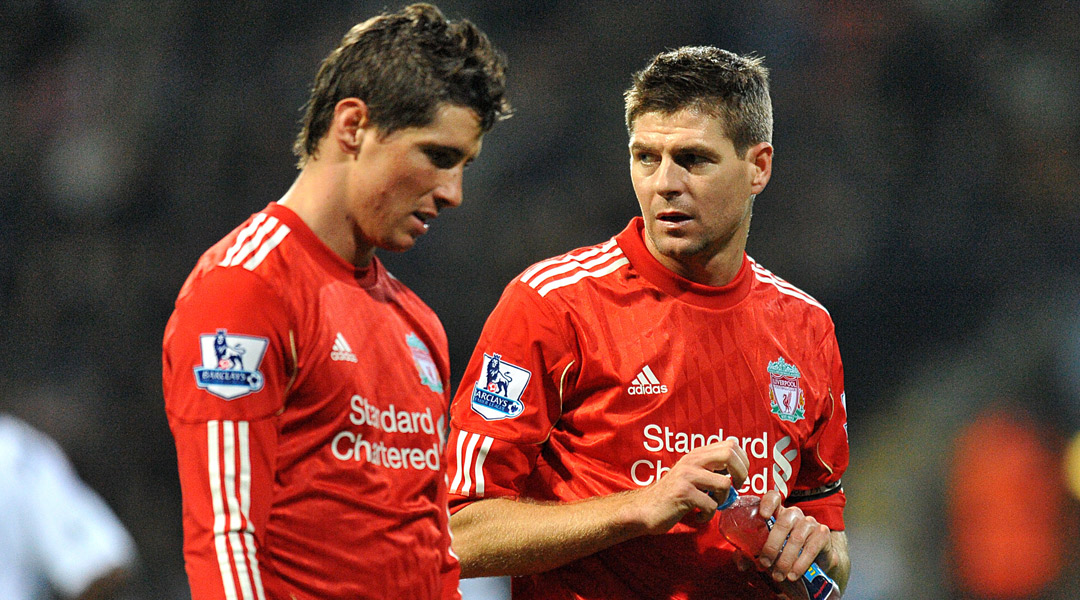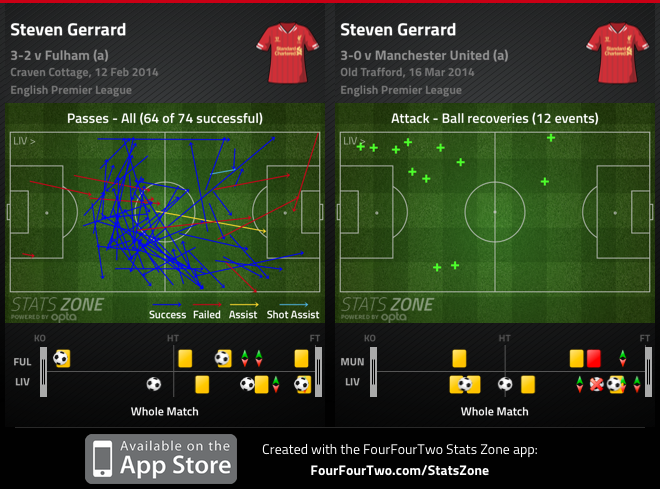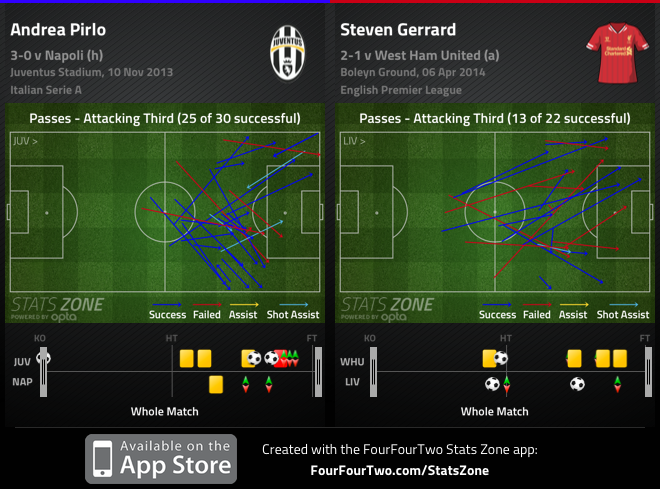Why Gerrard's switch to deep provides England with Pirlo-esque potential
Paul Wilkes assesses the tactical evolution of Steven Gerrard, and why England's midfield general should thrive in his new position for the Three Lions...

At the start of the calendar year, it wouldn't have been unfair to describe Steven Gerrard as the complete all-round midfielder; a player as comfortable making a 40-yard pass as a last-ditch tackle. One who can strike a thunderbolt from distance, but is also calm under pressure from the penalty spot.
The Liverpool captain has found himself moved around the team by various managers. He first made his debut at Anfield at right-back and was used primarily as a holding midfielder in his early years. Both Gerard Houllier and Rafael Benitez used him on the right of midfield at times, while he was regularly deployed on the left for Fabio Capello's England team.
Arguably his finest season was in the No.10 role behind Fernando Torres. Gerrard had the creativity to find the through ball in tight areas for his team-mate, whose speed opened up space between the lines for the Huyton-born midfielder. The understanding between the two was at a telepathic level, with the now-Chelsea forward admitting: "we were made for each other."

Gerrard's flexibility may have counted against him playing as a central midfielder more often throughout his career. However, his tactical naivety was noted: Benitez preferred to use him in attacking areas, deploying Dietmar Hamann, Xabi Alonso and Javier Mascherano to shield the defence at various times. "Gerrard's a great footballer, but perhaps not a great player," once said former Milan tactician Arrigo Sacchi.
Under Roy Hodgson and Kenny Dalglish, Gerrard was back in the centre of the pitch, which continued into Brendan Rodgers' first 18 months on Merseyside. The general theory was that he was more disciplined as he no longer had the energy to race up and down the pitch; there were times when his partnership with Lucas certainly lacked mobility.
Rolling in the deep
Liverpool's 5-0 win at White Hart Lane back in December wasn't just a pivotal moment for Andre Villas-Boas, who lost his job, but also for Liverpool's central midfield. It was Gerrard's first game out with a hamstring injury; as he watched the match as a television pundit, the 34-year-old would have been forgiven for wondering how he was going to get back into the side. The middle three of Joe Allen, Jordan Henderson and Lucas appeared to display the right combination of attributes.
Get FourFourTwo Newsletter
The best features, fun and footballing quizzes, straight to your inbox every week.
When Gerrard returned to the starting XI in the league, it was against Stoke in this newfound deep-lying playmaker role. It was difficult to tell at first that this would be the long-term plan. Liverpool won the game, but were far from in control after they let a two-goal lead slip. It was a Gerrard penalty that put them back in front early in the second half.

When Andreas Weimann did a good job of tracking Gerrard in the next game against Aston Villa, it led to questions about not only if the player was suited to the switch, but the time of implementation. Liverpool were going well in the league and looked on course for the top-four target that had been set. But Rodgers and Gerrard's persistence with the ideology led to the team's title challenge.
"I knew there would be a time in my career when I’d drop a bit deeper," Gerrard admitted before the Merseyside derby. "I’m not going to be the Steven Gerrard I’ve been for the last 15 years going from goal-line to goal-line."
"I think a really top performance from me in the next couple of games will make people realise why we are doing this and that it is the right time. This is not something that has just happened in the last two or three weeks but stems from our first conversation when he became manager."

As with everything Rodgers does tactically, there was a vision behind his reasoning. "I always felt he was going to have a big impact in the role he's in, purely because of his quality and intelligence," confessed the former Swansea coach. "He has been really consistent throughout the course of the season with his goals, but his playmaking ability from behind really gives the team a different dimension."
For England, Gerrard has played the position under Hodgson against the weaker nations like San Marino, but struggled to influence against stronger countries. With England lacking depth in the holding position in front of the back four, a consistent run of games in his new abode has certainly helped the national team. "Everyone knows Steven's qualities but I think it would be good for Roy to see him in that central pivot that we play," said Rodgers.
Pirlo persuasion
The comparisons with Italy's Andrea Pirlo are fair, and not just because they are two elder statesmen looking to control the tempo of their respective countries in Manaus.

Pirlo also started out as a more advanced midfielder. When Pirlo was 21, Carlo Mazzone converted the Milan-owned player into a regista at relegation-battling Brescia. "The intelligent players adapt and Gerrard has the ability to do that," Pirlo remarked. "He is an excellent passer of the ball, possesses an intelligent football brain, and has great vision."
Hodgson's biggest concern is whether he uses a two-man double pivot with Henderson providing the endurance, or a 4-3-3 with two more advanced runners. With his eagerness to start both Wayne Rooney and Daniel Sturridge, the former seems more likely against Italy.
When the sides met two years ago, Rooney followed Pirlo closely for the first 10 minutes, but the Juventus man proved elusive as he moved around the pitch to find space. The defensive work of the attacking personnel is crucial when facing deep creative players, although it can prove detrimental to their work in the final third of the pitch if they are unable to strike the right balance. They must get it right this time.

